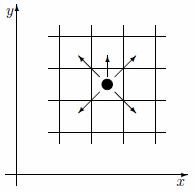Problem Statement |
| | In Japanese Chess, there is a piece called Silver. A Silver piece located in cell (x,y) can move to any of the following cells in one step: (x-1,y+1), (x,y+1), (x+1,y+1), (x-1,y-1), (x+1,y-1). In other words, it can move one cell in any of the four diagonal directions, or it can move one cell vertically in the positive y direction.

Initially, there's a Silver piece in cell (sx,sy) of an infinitely large board. Return the minimal number of steps required to move to cell (gx,gy). |
| |
Definition |
| | | Class: | SilverDistance | | Method: | minSteps | | Parameters: | int, int, int, int | | Returns: | int | | Method signature: | int minSteps(int sx, int sy, int gx, int gy) | | (be sure your method is public) |
|
| |
|
| |
Constraints |
| - | sx, sy, gx and gy will each be between -1,000,000 and 1,000,000 inclusive. |
| |
Examples |
| 0) | |
| | | Returns: 9 | | Move up vertically in the positive y direction 9 times. |
|
|
| 1) | |
| | | Returns: 5 | | Follow the path : (0,0) -> (-1,1) -> (-1,2) -> (-2,3) -> (-3,2) -> (-4,3) |
|
|
| 2) | |
| | | Returns: 8 | | Move up vertically in the postive y direction 3 times, then move diagonally up and to the right 5 times. |
|
|
| 3) | |
| | -487617 | 826524 | 892309 | -918045 |
| Returns: 1744571 | |
|
| 4) | |
| | | Returns: 0 | | The Silver is already in the goal. |
|
|
